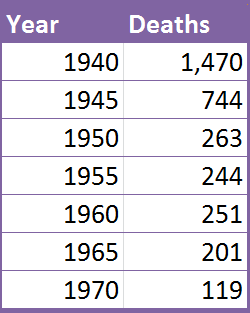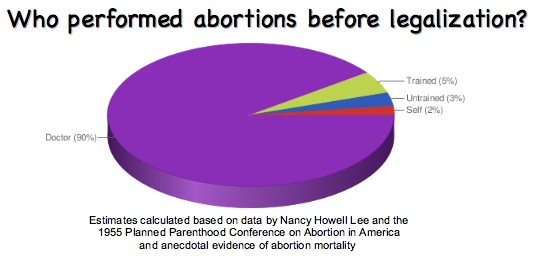 |
| Lawrence Lader |
The 5,000 - 10,000 claim is one of the standard abortion promotion tricks: misleading citing. Often you'll see abortion advocates citing some recent (or relatively recent) "research". But when you check their source, you'll find that the source cites an even older source. And when you check that source, you'll find that it cites yet another, older source. You'll go round and round. (I've often joked that tracking down pro-choice original source material gives me motion sickness.) Eventually, you'll find the original source. If you're persistent. And lucky.
In the case of the 5,000 - 10,000 claims, the original source was a book -- Abortion, Spontaneous and Induced -- published in 1936 by Dr. Frederick Taussig, a leading proponent of legalization of abortion. Taussig calculated an urban abortion rate based on records of a New York City birth control clinic, and a rural abortion rate based on some numbers given to him by some doctors in Iowa. He took a guess at a mortality rate, multiplied by his strangely generated estimate of how many criminal abortions were taking place, and presto! A myth is born!
 |
| Frederick Taussig |
 |
| Bernard Nathanson |
How many criminal abortion deaths were there, then? An excellent question, and a tricky one to answer. Before the Centers for Disease Control began Abortion Surveillance Activities in 1968, and began looking at abortion mortality in earnest in 1972, all abortion deaths were typically counted together: legal (or "therapeutic"), illegal, and spontaneous (miscarriage). However, even without the CDC's intervention, public health officials were watching maternal mortality in general, and abortion mortality in particular, very carefully. After all, abortion itself was a crime, and an abortion in which the mother died could well result in a homicide investigation. This was not petty crime; the police, coroners, funeral directors, and hospital administrators were very attentive to possible criminal abortion deaths.
Peer-reviewed articles published in the decades before Roe gave varied estimates of the number of abortion deaths annually. One study determined that there were approximately 1.3 criminal abortion deaths per year in Minnesota from 1950 through 1965. Commentary on that study pointed out that if researchers combined known criminal abortion deaths with suspected criminal abortion deaths, 4.4 women were dying from criminal abortions per year in Tennessee from 1955 through 1965. A study in California reported 30 total abortion deaths per year during a period studied from 1957 through 1965, and as many as 87% of those abortion deaths were due to criminal abortions. This meant a maximum death rate in California of 26 women per year during that period.
But what can that tell us about mortality nationwide? In 1975 (the first year for which complete numbers are available), Minnesota reported roughly 1.6% of all legal abortions, Tennessee reported about 1.7%, and California about 22%. It is reasonable to assume that the proportion of illegal abortions in each state before legalization would be similar to the proportion of legal abortions in each state after Roe. If each of those states had been representative of the nation at large, that would put the national death rate at 78, 225, and 104, respectively. If we combine the totals, we find 31.7 criminal abortion deaths per year in three states, which represented roughly 26% of abortion deaths. This would mean approximately 123 criminal abortion deaths annually in the decades just before Roe.
 |
| Mary Calderone |
Once more, with feeling:
 |
| Source: "Induced termination of pregnancy before and after Roe v. Wade" JAMA, 12/9/92, vol. 208, no. 22, p. 3231-3239. |
- In 1936, Frederick Taussig announced that there were 5,000 to 10,000 maternal deaths from criminal abortion annually in the United States.
- In 1942, Taussig admitted that his calculations had been wrong, and that there was no way as many as 5,000 women were dying, much less 10,000.
- From 1940 through 1970, abortion mortality fell from nearly 1,500 to a little over 100 (see table).
- In 1972, according to the Centers for Disease Control, 39 women died from criminal abortions. (This number was determined by sending out letters to health officials, hospitals, and doctors throughout the country, in addition to the usual reporting methods.)
 You would have to go back to before WWII to find as many as 1,000 women dying from criminal abortions annually in the United States. By 1967, when the first states started allowing very limited elective abortions, the number had fallen almost 90%, to 110. Criminal abortion deaths clearly were diminishing dramatically without taking the radical step of legalization. Other strategies, such as liberalizing sterilization laws, providing competent counseling to frightened pregnant women to help them overcome their fears about having their babies, and teaching doctors better diagnostic and treatment strategies for addressing criminal abortion complications, were based on sound research and were likely to reduce criminal abortion deaths to an unavoidable minimum. (As long as some women insist on having abortions, some of them will die, no matter how diligently we try to protect them.) When current strategies are working, it's foolish to throw a monkey wrench into the works. The stragegy of improved medical care was solving the problem. Abortion advocates might have done well to listen to the old adage, "If it ain't broke, don't fix it."
You would have to go back to before WWII to find as many as 1,000 women dying from criminal abortions annually in the United States. By 1967, when the first states started allowing very limited elective abortions, the number had fallen almost 90%, to 110. Criminal abortion deaths clearly were diminishing dramatically without taking the radical step of legalization. Other strategies, such as liberalizing sterilization laws, providing competent counseling to frightened pregnant women to help them overcome their fears about having their babies, and teaching doctors better diagnostic and treatment strategies for addressing criminal abortion complications, were based on sound research and were likely to reduce criminal abortion deaths to an unavoidable minimum. (As long as some women insist on having abortions, some of them will die, no matter how diligently we try to protect them.) When current strategies are working, it's foolish to throw a monkey wrench into the works. The stragegy of improved medical care was solving the problem. Abortion advocates might have done well to listen to the old adage, "If it ain't broke, don't fix it."
For more on pre-legalization abortion, see The Bad Old Days of Abortion
To email this post to a friend, use the icon below.

No comments:
Post a Comment